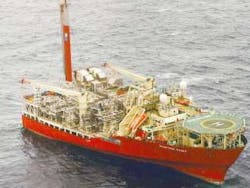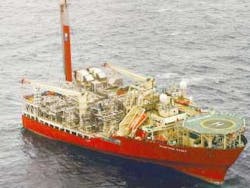CNR aiming to revive Banff
Jeremy Beckman • London
Canadian Natural Resources is set to take over the reins at a third production complex in the UK North Sea. Subject to government and partner approval, it will operate the Banff oil and gas field in central block 29/2a, having agreed to purchase ConocoPhillips' 31.7% interest. This will raise CNR's percentage in Banff to 87.6%, in line with its policy of securing near outright control of its North Sea properties.
CNR has gained a reputation for tail-end management of mature fields with large platforms. Banff is not in that category, having come into full production early in 1999 through a turret-moored, Ramform-type FPSO in 100 m of water. First production was from an extended well test in 1996. The original reserves estimate was 10 million metric tons of oil and 80 bcm of gas.
null
Current production is around 10,000 b/d of oil and 35 MMcf/d of gas. The crude is offloaded to shuttle tankers, and much of the operation – including logistics – has been managed by PGS. Two years ago, progress was checked by stability problems with the vessel, which led to an extended shutdown period while new bilge keels were fitted.
Around the same time, reservoir producibility concerns led the partners to cease water injection into the reservoir. Originally, the Kyle accumulation, also operated by CNR, was considered as a tieback to Banff, but this was developed through Shell's Curlew FPSO.
ConocoPhillips has been blunt that its priorities as a newly merged company are its larger assets elsewhere in UK and Norwegian waters. According to Martin Cole, managing director of CNR International (UK), "The contracting strategy that Conoco adopted from the outset on Banff was very much hands off, apart from drilling and reservoir management. We now hold far more equity than Conoco ever did, and we will be looking for new synergies with Kyle. We also have other plans to re-assess the reservoir and to examine new exploration prospects."
Another Central North Sea floater, the Haewene Brim on Shell's Pierce field, will come off station for seven weeks next summer. The vessel will be taken to a shipyard in western Europe, where £50 million of new water injection facilities will be installed, capable of handling up to 95,000 b/d of injection water, via two new dedicated wells. Main components will include a de-aerator tower, pumps and filter units. Pierce, which has been onstream since February 1999, currently exports 30,000 b/d of oil via shuttle tankers. Bluewater, which owns and operates the Haewene Brim, is also managing the new project.
Dutch outlet for Danish gas
Denmark will join the ranks of gas exporters to mainland Europe. Agreement has been reached between state oil company Dong and the DUC consortium (A.P. Møller-Mærsk, ChevronTexaco, and Shell) to install a 100-km, 26-in. pipeline from DUC's Tyra production complex. This will take a southwesterly track through Danish, German, and Dutch waters, connecting to the Nogat trunkline system at Den Helder. The new line, which will be operated by Mærsk and installed by Allseas' Solitaire lay barge, should be fully operational in 2004. Total investments, including associated new facilities, are estimated at DKr1 billion.
The project was made possible by liberalization of the Danish domestic market. Previously, Dong was the monopoly gas distributor, but it was also committed to take all the consortium's produced gas, which was outstripping the country's needs. According to field analysts Scanboss, the partners had also considered taking the new line into Norway's Norpipe trunkline system, which runs from Ekofisk to Emden in northern Germany, but the Norpipe licensees tried to drive too hard a bargain.
Some supplies for the new line could come from Mærsk's Halfdan northeast development, which was approved this July. Under a first phase, three long-reach wells will be drilled from the Halfdan BA satellite platform to exploit accumulations formerly known as Igor and Sif. Again, Allseas is laying the 24-in. multi-phase line taking the wellstream from the platform to Tyra West. Later, three more wells and a dedicated platform on Igor could follow. The new connection into Nogat could also serve as a point of entry for Danish gas exports to the UK.
In the Norwegian sector, Norsk Hydro has confirmed that Easington, eastern England, is its chosen landfall point for gas from the 375-bcm Ormen Lange field in mid-Norway. Although the Ormen Lange development plan has yet to be approved, Centrica has been contracted to build and operate a new gas reception facility next to its existing terminal, capable of handling up to 70 MMcf/d, more than 10% of the UK's needs. Statoil has also tied up a new contract with Centrica to supply a further 2 bcm/yr to Britain over the next three years.
Ekofisk recovery still climbing
Ongoing enhancement measures at Ekofisk have boosted recovery to 46%, said Lars Takla, managing director of operator ConocoPhillips, at Offshore Europe. The realistic longer-term goal was 50%, he added, pointing out that each 1% gain was equivalent to 85 MMboe.
"This is a high porosity, low permeability chalk reservoir, although the fracturing also helps drain the oil very quickly." Water injection, now running at nearly 1 MMb/d, has helped push oil production to its present level of 140,000 b/d, with slightly lower gas output than before. "We still have individual wells coming in at 10,000 b/d at the weak spots where the oil is really being pushed."
The partners were looking to achieve better rates through new multilateral wells, he said. Other measures aiding recovery include increased real time monitoring of drill bit steering from an onshore drilling center, via a fiber-optic cable link from Ekofisk.
"Using our 3D view of the reservoir, we can solve problems as we drill. Last year, we also opened a Center for Improved Oil Recovery, comprising personnel from Stavanger University, Rogalands Research and the Ekofisk group, to improve understanding of the fundamentals of the reservoir," he said.
Additionally, the European Union is funding a program examining air injection as a new method of driving up recovery. The technique, which is already applied on land, could be viable on Ekofisk within five to ten years, Takla said.
Second platform for Britannia
In the UK, ConocoPhillips has awarded Amec a $47-million front-end engineering design contract for phase one of a development known as Britsats 1. This involves a new platform bridge-linked to the existing Britannia production installation, serving as a processing facility for the Brodgar and Callanish satellites. Construction work would reportedly start next summer, leading to first production in late 2006.
Elsewhere on the UK shelf, Venture Produc-tion's recent well on Annabel in the southern gas basin, drilled by the jackup Noble Ronald Hoope, tested gas at over 50 MMcf/d, and log data indicates a gas column of at least 560 ft. Venture is keen to develop the accumulation as quickly as possible through its newly-operated Audrey complex, with production exported to Theddlethorpe in Lincolnshire via the Loggs trunkline system.
BP claims to have found 30 MMbbl of oil in the Farragon prospect in the central sector, close to Andrew.

